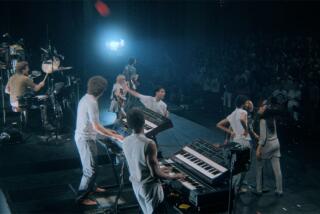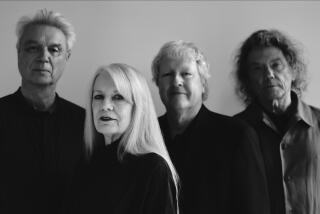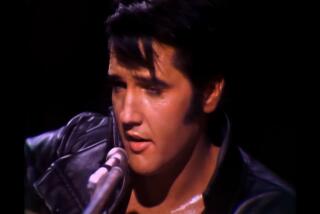‘T.N.T.’ is ‘60s dynamite
If you hang around die-hard music fans long enough you end up hearing them extol the virtues of a few key cult films that capture the heyday of L.A.’s 1960s music explosion.
One of the most difficult movies to find (still not being available on DVD) is “The Big T.N.T. Show,” filmed in November 1965 at the Moulin Rouge, a club at the corner of Sunset and Vine that opened in 1938 as the Earl Carroll Theater. Soon after the “T.N.T. Show” filming, the club re-emerged as the Hullabaloo, which was briefly the most prestigious club to play on the Sunset Strip, showcasing such artists as the Buffalo Springfield, the Yardbirds, the Mamas and the Papas, Richard Pryor, the Electric Prunes and Paul Revere and the Raiders.
But no show could equal the star power that was on hand for “The Big T.N.T. Show,” which will have a rare screening tonight at 9:15 as part of a three-night film extravaganza sponsored by the American Cinematheque at the Egyptian Theatre. (The film is on a double bill with 1940’s “A Night at Earl Carroll’s,” which plays at 7:30.) The series, called “Riot on Sunset Strip: Part II,” was assembled by Domenic Priore, a writer and filmmaker whose book “Riot on Sunset Strip: Rock ‘n’ Roll’s Last Stand in Hollywood” is an indispensable guide to the brief flowering of L.A.’s ‘60s rock scene.
What makes “The Big T.N.T. Show” so intriguing is that it brings together such a wide variety of musicians on one stage. With Phil Spector serving as musical director -- and, according to Priore, one of the film’s financiers -- we get to see rock, soul, country, pop and folk artists all in one place at one time, surrounded by an audience of screaming girls.
At its heart, the film is still a variety show, but it’s an eye-opener to see the breadth of ‘60s sounds, with the bill featuring the likes of the Byrds, Bo Diddley, Lovin’ Spoonful, Ike and Tina Turner, Roger Miller, Joan Baez, Ray Charles, Donovan and Petula Clark.
The show’s best moments are its surprises, none bigger than seeing Spector, wearing a beret, sitting at the piano and conducting the band as Joan Baez belts out a brassy version of “You’ve Lost That Loving Feeling.”
Some of the performances haven’t worn so well. Petula Clark looks about as hip as Julie Andrews doing a Spector-ized version of “Downtown.” Even though they’re gorgeous in their black turtlenecks and pencil-thin pants, the Byrds sound a little ragged, while Roger Miller looks totally out of his element in a suit and tie.
For my money, the artists who best survive the test of time are the African American performers, who’d clearly had far more experience on stage than most of the young rock acts.
It’s hard to take your eyes off Bo Diddley, while Ray Charles is extraordinarily smooth and soulful. (When one of his musicians forgets to come in at the beginning of “Let the Good Times Roll,” Charles cracks up and stops the band, calling out “Hey, who are you waitin’ on?” before taking it from the top.) The show concludes with Ike and Tina Turner, who were clearly an impossible act to follow.
“I remember the first time I watched the film with my friends, we’d have these tremendous arguments about who was better -- Ike and Tina or Bo Diddley,” Priore told me. “The Ike and Tina footage is not only stunning, but it’s probably the best footage anyone has seen of them on film. There wasn’t a lot of rock and soul music captured on TV in that era, so it’s really great to have a movie where you get to see so many artists at their best.”--
More to Read
The biggest entertainment stories
Get our big stories about Hollywood, film, television, music, arts, culture and more right in your inbox as soon as they publish.
You may occasionally receive promotional content from the Los Angeles Times.










